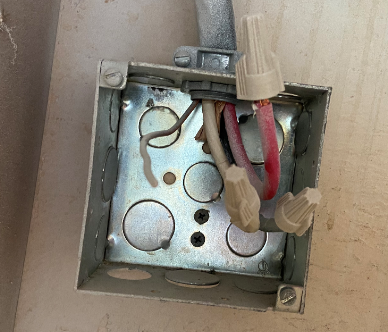California house built in the 1960s. Here's the existing junction box for the ovens. Ovens are busted and needed to be replaced
Right away, I am confused:
- Red looks like 8 AWG
- Black, White look like 10 AWG
- Bare wire (ground?) looks like 12 AWG
- Jacket for the 4-wire is plastic/polymer, not metal
I'd feel more comfortable if they were all the same wire gauge. I don't really want to pull new wire from the breaker box.
This used to connect to a Double Oven that we are replacing with a Whirlpool Double Oven. Each oven is a 4-wire connection. Not a big deal, just match the colors to wire it up. However, I need to add more wire!
The whip on the ovens are too short for both to reach this box. I assume the solution is: add a junction box and wire both ovens into a single box right between the two ovens (vertically). No problem. Plenty of room.
Then a trip to the hardware store and some searching on the Internet made it complicated:
- There's no grounding "hump" on the original junction box. Just tie the bare wire to the box with the screws for the coverplate or replace the box?
- Use a metal box for the new junction box? or plastic?
- I plan to run flexible conduit from the new box to the original box. Metal conduit + metal box? Ground them both with the bare wire? PVC conduit + plastic box because there's no metal conduit running back to the breaker box?
- The Whirlpool ovens have 12 AWG. Can I run 12 AWG in the conduit?
- The whip on the Whirlpool says connect ground with 8 AWG. Doesn't look like I have 8 AWG ground wire. Whirlpool supplies 12 AWG on their whip. What is the point of connecting a 12 AWG ground from the oven to a 8 AWG from the house?
- I'd love to use this EZ-QUICK (modular cable assembly). However, you can either get 12/2 or 10/3. The 10/3 is a polymer coated conduit with only (x3) conductors and I need (x4) 10/3 at Home Depot. Looks like I cannot use this. Instead, I need to get bona fide 10/3 Example from Home Depot and need to remove the jacket, strip the wires, add a clamp to the box myself.
If I can resolve what boxes to use and I can use the existing wiring, I'm confident to proceed. If I need to pull new wiring from the breaker box and/or put in better grounding, I don't want to do all that myself.
Am I in over my head and I should hire somebody, or am I close enough that I can do this myself?


